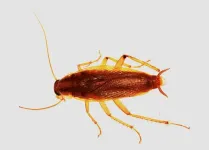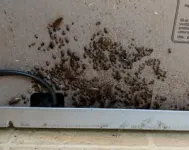Residual insecticides are designed to be sprayed on surfaces where cockroaches are likely to appear, exposing them to the toxic ingredient when they move across the surface later. But laboratory testing by researchers at the University of Kentucky and Auburn University shows that the residues have little effect on German cockroaches (Blattella germanica), a primary species infesting homes and buildings around the world.
The study found that liquid and aerosol sprays using pyrethroid insecticides killed less than 20 percent of German cockroaches that were exposed to sprayed surfaces for 30 minutes. Moreover, even when cockroaches were confined to the sprayed surfaces, most products took eight to 24 hours to kill the cockroaches, with some taking up to five days. Published August 14 in the Journal of Economic Entomology, the study tested the sprays on German cockroaches that had been collected from real-world infestations, where the insects have evolved resistance to pyrethroids, previous research shows.
"If residents do not have access to effective professional pest control or consumer solutions, they continue to be impacted by the effects of an infestation, including the health risks associated with cockroach allergens. Home is where people should be able to relax and feel comfortable," says Johnalyn Gordon, Ph.D., lead author on the study and a postdoctoral associate at the University of Florida. Gordon conducted the study while a graduate research assistant at the University of Kentucky in the lab of Zach DeVries, Ph.D., assistant professor of urban entomology and senior author on the study. Their study was supported by a grant from the U.S Department of Housing and Urban Development.
Cockroach control, while challenging at times, is obtainable, the researchers say, but it typically is time intensive and costly in terms of products applied. A key problem is that German cockroaches are almost universally resistant to pyrethroids.
"Due to the frequent use of pyrethroid-based residual products, it is very likely that German cockroaches inside of homes will have some degree of pyrethroid resistance," Gordon says. "To the best of our knowledge, a pyrethroid-susceptible German cockroach population has not been documented from the field in decades."
However, current requirements from the U.S. Environmental Protection Agency do not require insecticide products to be tested on cockroaches recently collected from the field or with demonstrated insecticide resistance.
"Hopefully studies like this one can drive changes in product testing and evaluation, so that labels accurately reflect the level of control these products can provide," Gordon says.
Additional factors likely contribute to the poor performance of the residual spray products, such as surface type and cockroach behavior. Gordon and colleagues tested the sprays on painted drywall, ceramic tile, and stainless steel and found that they performed significantly worse on drywall. Even a population of cockroaches without resistance to pyrethroids that was included in the study was minimally affected by the residual sprays on drywall. "This suggests that how porous a surface is may have a significant impact on product efficacy," Gordon says. "Given common applications of residual insecticides along baseboards, reduced efficacy on painted drywall was a particularly striking finding."
Meanwhile, cockroaches are unlikely to come to rest for extended periods on surfaces treated with insecticides, both because they are often on the move and because they may actively avoid them. A separate study in DeVries' lab published last year found resistant German cockroaches will not remain in contact with pyrethroid-treated surfaces for an extended period time, if given the choice.
Combined, these factors paint a dim picture for cockroach control via insecticide sprays. "Based on our results, pyrethroid-based DIY products are likely to fail against German cockroaches inside the home, especially if they are being used as residual products," Gordon says.
More promising DIY options for cockroach control include gel or liquid baits, which attract roaches to a food source laden with a slow-acting insecticide, Gordon says. Ideally, consumers could also have access to affordable professional pest-control services that take a multipronged approach known as integrated pest management, or IPM. However, this is often not the case for residents of low-income, multi-family housing, where cockroach infestations are often stubbornly persistent.
"There is a strong base of knowledge and research on how we can control cockroaches, but there are numerous economic and procedural barriers that mean that this control is not occurring in these areas, arguably where it is the most needed," Gordon says. "Targeting improved technologies that can close these management gaps is really critical to achieving accessible pest management, whether that is through different active ingredients and modes of action, formulations, or product-deployment strategies."
###
"Common consumer residual insecticides lack efficacy against insecticide-susceptible and resistant populations of the German cockroach (Blattodea: Ectobiidae)" will be published online on August 14 in the Journal of Economic Entomology. Journalists may request advance copies of the article via the contact below or download the published paper after 10 a.m. U.S. ET, August 14, at https://doi.org/10.1093/jee/toae158.
CONTACT: Joe Rominiecki, jrominiecki@entsoc.org, 301-731-4535 x3009
ABOUT: ESA is the largest organization in the world serving the professional and scientific needs of entomologists and people in related disciplines. Founded in 1889, ESA today has nearly 7,000 members affiliated with educational institutions, health agencies, private industry, and government. Headquartered in Annapolis, Maryland, the Society stands ready as a non-partisan scientific and educational resource for all insect-related topics. For more information, visit www.entsoc.org.
The Journal of Economic Entomology publishes research on the economic significance of insects and is the most-cited journal in entomology. It includes sections on apiculture and social insects, insecticides, biological control, household and structural insects, crop protection, forest entomology, and more. For more information, visit https://academic.oup.com/jee, or visit www.insectscience.org to view the full portfolio of ESA journals and publications.
END
Understanding Spreads and Commissions in Forex Trading
(Press-news.org) Understanding spreads and commissions in forex trading is essential for anyone looking to succeed in the currency markets, and it is equally important for those who work with forex brokers to grasp these concepts thoroughly. In forex trading, spreads and commissions represent the primary costs associated with opening and closing positions, and these costs not only affect overall profitability but also influence trading strategies and risk management. A solid grasp of these concepts allows traders to make informed decisions and choose forex brokers that align with their trading goals, ensuring they are equipped to navigate the competitive landscape.The spread is the difference between the bid price and the ask price of a currency pair, and it plays a crucial role in the cost structure offered by forex brokers. When a trader opens a position, they effectively enter the market at a slight disadvantage equivalent to the size of the spread. This cost is built into the price and represents the forex broker’s profit margin on the trade. Unlike a commission fee, which is explicitly charged, the spread is a hidden cost that continuously affects every transaction. The size of the spread can vary significantly depending on market conditions, the liquidity of the currency pair, and the pricing model adopted by forex brokers. For instance, during periods of high market volatility or low liquidity, spreads tend to widen, thereby increasing trading costs and potentially impacting overall profitability. Traders must be aware of the typical spread values for the pairs they trade and consider how these values align with their trading frequency and strategy when selecting forex brokers.
Commission fees, in contrast, are a direct charge that forex brokers apply to each trade. Some forex brokers offer pricing models that include narrow spreads but compensate for this by charging a separate commission for each transaction. This commission is usually calculated either on a per-trade basis or as a percentage of the transaction value. The advantage of this pricing model is that it often results in tighter spreads, which can be particularly beneficial for high-frequency traders who execute numerous trades throughout the day. However, the commission fee can add up over time, especially for traders who operate in large volumes or who trade very frequently. Therefore, it becomes essential for traders to evaluate whether the overall cost structure of low spreads with commissions or higher spreads without commissions better suits their individual trading style and objectives when working with forex brokers.
Both spreads and commissions have a direct impact on a trader’s break-even point and overall profitability. When a trader factors in these costs, even minor differences in spread or commission fees can significantly affect performance, especially for strategies that rely on small, incremental gains. Tighter spreads or lower commission fees are advantageous in short-term trading strategies where small price movements are targeted for profit. In contrast, for longer-term trades or positions held over extended periods, the relative impact of these costs may be less significant compared to broader market trends or fundamental shifts in currency values. This relationship emphasizes the importance of understanding how transaction costs integrate into the overall trading plan and risk management strategy—a factor that forex brokers often highlight in their educational materials and client briefings.
Another critical aspect of understanding these costs is transparency and consistency, both of which are hallmarks of reputable forex brokers. Well-established forex brokers clearly disclose their spread and commission policies, enabling traders to calculate potential costs accurately before engaging in trades. Some forex brokers might advertise “zero commission” trading, but this often comes with the trade-off of wider spreads, a nuance that may not always be beneficial for every trading strategy. It is crucial for traders to examine the fine print and understand the real cost of trading with a given forex broker, taking into account both the explicit and hidden fees associated with their transactions.
Market conditions play a pivotal role in shaping both spreads and commission structures. During times of economic uncertainty or significant market events, liquidity can diminish, which often leads to wider spreads and higher trading costs. Seasoned traders, especially those who have strong relationships with reliable forex brokers, monitor these changes closely and may adjust their strategies accordingly, sometimes opting for currency pairs that maintain tighter spreads even during turbulent market conditions. Understanding these dynamics enables traders to anticipate cost fluctuations and manage risk more effectively. For example, during major economic announcements, traders might reduce their exposure or employ additional risk management measures to mitigate the impact of potentially wider spreads, a strategy that many forex brokers advise.
Moreover, the evolution of technology and trading platforms has added layers of sophistication to how spreads and commissions are managed and presented to traders. Modern trading platforms offered by forex brokers often incorporate real-time analytics, allowing traders to monitor current spread values and compare them with historical data. This capability provides traders with a more dynamic approach to cost management, where they can adjust their trading strategies based on up-to-date market conditions. Additionally, some platforms offer customizable alerts, notifying traders when spreads widen beyond a certain threshold, which can be particularly useful in volatile markets. This integration of technology helps bridge the gap between theoretical cost structures and practical, real-time trading experiences, and is one of the many advantages that savvy traders look for in forex brokers.
Historical trends in forex trading also offer insights into how spreads and commissions have evolved over time, particularly as forex brokers have adapted to the growing retail trading market. In earlier decades, forex trading was largely accessible only to large financial institutions, where spreads were relatively narrow due to high liquidity and significant market participation. However, with the advent of online trading platforms and increased competition among forex brokers, retail traders have seen a diversification in pricing models. Today, some forex brokers offer variable spreads that fluctuate with market conditions, while others provide fixed spreads, offering predictability even if the cost might be marginally higher. This evolution reflects a broader trend towards more trader-friendly practices, where transparency and competitive pricing have become central to a forex broker’s value proposition.
In conclusion, comprehending the intricacies of spreads and commissions in forex trading is fundamental for managing trading costs and optimizing profitability, and understanding these factors is critical when selecting forex brokers. Traders need to consider how these expenses fit into their overall strategy and select forex brokers whose fee structures align with their trading habits and risk tolerance. Whether one opts for a model that features narrow spreads with separate commissions or prefers an all-inclusive approach with higher spreads, the key is to remain informed and adaptable in an ever-changing market environment. By carefully evaluating both explicit and hidden trading costs, traders can mitigate adverse impacts on their profit margins and position themselves for long-term success in the competitive world of forex trading. This comprehensive understanding not only aids in cost management but also enhances overall trading discipline, contributing to more effective risk management and improved decision-making over time—a commitment that is often at the core of the service provided by top forex brokers.




